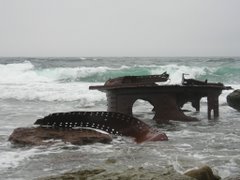 In Labrador, the local anglers favor spinning gear for sea trout. Eyes opened wide, seeing Steve and me on the rocky shore with our fly rods tucked under our ams, stripping line with both hands. They opened even wider at the sight of us releasing sea run Brookies. By noon on our second day, we started to draw a crowd.
In Labrador, the local anglers favor spinning gear for sea trout. Eyes opened wide, seeing Steve and me on the rocky shore with our fly rods tucked under our ams, stripping line with both hands. They opened even wider at the sight of us releasing sea run Brookies. By noon on our second day, we started to draw a crowd.
The word was out that the sea trout were in at Buckle's Point. Two CFA's (Come From Aways) were forking them in with fly rods - and throwing them back! No one had ever heard of such foolishness. Local anglers arrived by the truckload to get in on the action.
They weren't long finding out there wasn't much action to be had on the spinning rod. Catches were few and far between, except for those alien fly fishers with their annoying habit of releasing trophy trout. When a kid came up to me and asked if he could have the 20" trout I was releasing, I probably should have said yes. Instead, I gave the boy a purple Cardinelle fly and invited him to catch his own.
About that time, Steve approached me and said, "I've been chatting with a fellow over there for the past half hour. He wants us to come up to his house for a cup of tea and some smoked trout. What do you think?"
And that's how we came to meet Uncle Parker, and his nephews, Gavin, and young Bobby. The three of them were licensed guides, and they were there out of pure curiosity. They wanted to see with their own eyes what all the fuss was about on Buckle's Point - two guys fishing in the bay with fly rods!
I'll make a long story short by saying that we spent the night tying flies, drinking 12 year-old scotch and smoking cigars at young Bobby's. The next morning, we were back at Buckle's Point with Parker. Steve told me later that, at one point, he looked up the shore and saw half a dozen local anglers with fly rods tucked under their arms, stripping like madmen.
Here are a few tips about fly fishing in salt water:
Use a full sinking line - it will be no fun to cast with, but absolutely essential for getting the fly to where the fish are.
Stand on a high rock near shore, if possible. There are three advantages to this - the first is better visibility into the water, the second is less risk of smashing your fly on the rocks behind you, the third is achieving maximum casting range.
Speaking of visibility, wear a broad-brimmed hat and polarized sunglasses. Position yourself so that there is an area of sandy bottom nearby, if possible. Sea trout can be very difficult to see in salt water, except when they cross a patch of light sandy bottom.
In general, cast as far as you can, and let the fly sink. Tuck your rod under your arm and strip hard and fast with both hands.
Use a stripping basket. I learned this in Long Beach, California, fishing for Corbina. A stripping basket attaches to your waist with a belt and allows for better line control. It's not absolutely necessary, but makes the whole business a lot safer and more enjoyable. If you don't use one, be prepared to spend a lot of time freeing the line from tangles with rocks and seaweed at your feet. You can spend from $20 to $100 for a stripping basket or you can make your own for less than $10.
A marabou fly, such as a Cardinelle, or Wooly Bugger has a seductive pulsating action that trout seem to go for. Tie them big - you want something at least three inches long. I like to tie them with two contrasting colors of marabou - purple and pink, pink and yelow, or red and white are good choices.
Always rinse your rod, your reel, and any flies you might want to use again in fresh water after a day in the salt.
Good Luck and Good Fishin'!
-Random Phrump
Monday, March 10, 2008
Buckle's Point Revisited - Part 2
Posted by
Random Phrump
at
10:38 AM
![]()
Labels: Buckle's Point, Cardinelle, Forteau, Labrador, marabou, Parker Suley, polarized glasses, Sea Trout, Steve Dobson
Subscribe to:
Post Comments (Atom)




2 comments:
Good telling of the story.
Man, it is great when everything comes together like it did at Buckles Point. That smoked trout was pretty good too.
Cheers,
Steve
Such stuff as dreams are made of...
Post a Comment